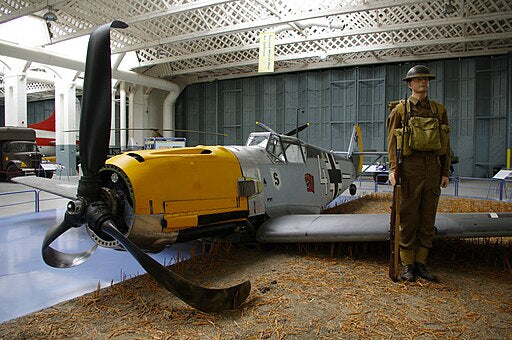The Messerschmitt Bf 109 wasn’t just another plane on the German roster—it was the star of the show during World War II. From duking it out in Britain’s moody skies, cruising high above the vast stretches of the Eastern Front, to zipping beneath the sun-soaked blues of the Mediterranean, the Bf 109 was more than just a piece of the wartime puzzle; it was the whole picture.
The Battle of Britain: Dueling for Dominance
In the summer of 1940, the skies over Britain echoed with the drone of aircraft engines. The Bf 109 was right in the thick of the gnarliest aerial brawls the world’s ever witnessed. And even though its design roots trace back to the 1930s, the Messerschmitt was far from being some dusty relic. Due to its knack for adjusting to the times, it could go toe-to-toe with Britain’s latest and greatest, especially icons like the Spitfire and Hurricane.
Set side by side with the sleek curves of the Spitfire, the Bf 109, with its sharp angles, really showcased German engineering finesse. The Bf 109 was essentially the face of the Luftwaffe’s muscle. But even the best have their off days, and the Battle of Britain sure did spotlight a few chinks in its armor. The Bf 109’s limited fuel capacity constrained its loiter time over England, rendering extended engagements risky. While it had the power to challenge the Spitfire in head-on duels, the British island’s resilience, combined with the Royal Air Force’s tenacity, ultimately denied the Luftwaffe aerial supremacy.
The Eastern Front: A Brutal Skyward Struggle
In contrast, on the Eastern Front, the Bf 109 faced not only the Red Air Force’s aircraft but also the challenges of vast distances and extreme climatic conditions. This aircraft found itself up against robust Soviet designs like the Yakovlev Yak-1 and the Lavochkin La-5.
Yet, the Bf 109’s versatility shone through in this harsh theater. It was far from a one-hit wonder. The Bf 109 could mix it up in dogfights, swat bombers out of the sky, and wasn’t shy about ground combat either. With Operation Barbarossa in 1941, the Bf 109 led the charge, backing up the Wehrmacht as they dove deep into Soviet turf.
As the war continued, the Soviets wouldn’t let up and continued to pump out planes. This started putting the squeeze on the Luftwaffe’s top-dog status. The Bf 109 still had plenty of fight left in it, but by 1944, with the Soviets rolling out their latest flying tech and the Germans struggling to keep their supply trains running, the Eastern Front’s skies turned into anyone’s game.
The Mediterranean: An Arena of Tactical Ingenuity
In the Mediterranean, the conflict’s nature demanded a different air combat style. Naval operations, island-hopping campaigns, and tactical support for ground troops characterized the theater. The Bf 109 was once again tasked with many roles, from protecting shipping convoys to supporting the German and Italian armies in North Africa.
Here, against adversaries like the American P-40 Warhawk and the British Spitfire, the Bf 109 pilots were often called upon to demonstrate tactical ingenuity. The vast maritime landscape meant that dogfights were not just about outright power or speed; they were chess matches in the sky, demanding strategy, cunning, and foresight.
The Messerschmitt Bf 109’s journey through these theaters reflects the broader narrative of World War II. From the intense aerial jousts over Britain to the strategic duels on the Eastern Front and the tactical problems of the Mediterranean, the Bf 109 remained a cornerstone of the German aerial effort. Through it all, this aircraft bore witness to the evolving nature of aerial warfare, demonstrating both its strengths and its vulnerabilities. It remains, unquestionably, a symbol of a turbulent era in our history.
For more insights into the Messerschmitt Bf 109 and other important military aircraft, visit Aces In Action. Here, you’ll find an amazing piece of artwork by Craig Tinder titled “Jagdgeschwader 51” which depicts Luftwaffe Ace, Werner Mölders and his wingman searching for new targets over the Eastern Front. The limited edition canvas print even includes a piece of aluminum skin discovered outside of the town of Gumrak, Russia – close to the Volgograd (known as Stalingrad) airport, making it a unique piece of history!
Jagdgeschwader 51 – Messerschmitt Bf 109 Aviation Art by Artist Craig Tinder
Considered by many to be one of the most influential fighter aces of WWII, Werner Mölders became the first combat pilot ever to amass 100 aerial victories. In 1941, he was promoted to Inspector of General Fighters but was killed in a flying accident en route to the World War I Flying Ace, Ernst Udet’s funeral. Mölders authored many of the Luftwaffe tactical doctrines and dog fighting techniques still used to this day.
To purchase or see similar items, visit here.
Commissioned by Museums, Treasured by Collectors





Share:
Firepower from Above, the story behind "Wicked Wanda"
The B-1 Bomber’s Swing-Wing Design: How and Why It Works